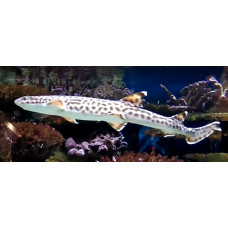Latin name
Atelomycterus marmoratus
Other name
Atelomycterus marmoratus
Identification
The Coral Catshark has a very slender, cylindrical, dense body and a short, narrow head. The snout is short and slightly flattened with a blunt tip. The eyes are oval, horizontally elongated, with rudimentary nictitating membranes and medium-sized spiracles behind the eyes. The large nostrils are covered with broad, triangular skin folds, leaving small openings in and out. The nasal folds extend to the mouth, hiding the wide grooves at the corners that connect the nostril opening to the mouth. The small teeth have a narrow central point surrounded by 1-2 small pointed projections on either side. This species has five pairs of gill slits.
Features of fish fins
The pectoral fins are quite large. The first dorsal fin is inclined forward and originates above the posterior edge of the pelvic fins. The second dorsal fin has the same shape and is slightly smaller than the first. Its base is on the anterior quarter of the base of the anal fin. Adult males have thin, tapering pterygopodia that are about 2/3 the length of the distance between the pelvic and anal fins. The anal fin is considerably smaller than the dorsal fins. The caudal fin is relatively short and broad, with an undeveloped lower lobe and a ventral notch near the tip of the upper lobe. The thick skin is covered with hard placoid scales.
Fish colouring
The coloration of these fish is very varied, with numerous black and white spots scattered on a gray background. These spots sometimes merge to form horizontal markings that cover the dorsal fin and gill slits. The belly is uniformly white.
Distribution
Most common off the coasts of Pakistan and India, and in Southeast Asia in Taiwan, the Philippines, and New Guinea. The range extends north to the Ryukyu Islands.
Habitat
These sharks are bottom dwellers that inhabit nearshore coral reefs at depths of 15 meters or less.
Size
Coral cat sharks grow up to 70 centimeters in length.
Behavior
The elongated body of Atelomycterus marmoratus allows it to move in narrow reef crevices, although it cannot "crawl" with its pectoral and pelvic fins like Hemiscyllium ocellatum. This species is primarily crepuscular and nocturnal, beginning to hunt actively in the afternoon and before sunrise. During the day this shark is usually found hiding individually or in groups under the reef vaults. Some individuals return to the same shelter for several days.
Food and feeding habits
This species feeds on small bottom-dwelling invertebrates and bony fish.
Reproduction
Coral catsharks reproduce by laying eggs that are enclosed in a capsule. These capsules are called "mermaid purses" because of their shape. Females usually lay 2 eggs at a time. The capsule is about 6-8 cm long and 2 cm wide, with two constrictions; one end of the capsule is square, while the other end has two short "horns" that may end in short antennae. The female lays her eggs on the ground. The newly laid capsule is light brown and darkens with time. Newborns hatch within 4-6 months at 26В°C. Aculeates are difficult to see, probably because they are hiding from predators on the reef. They are 10-13 cm long and also have a contrasting pattern of light and dark vertical stripes on their backs, sometimes with black and white dots. At the age of three months they grow to 4-5 cm and their coloration becomes the same as that of adult sharks. Males and females reach sexual maturity at 47-62 cm in length.
Fishing
Small numbers of these sharks are caught by artisanal fishermen on the reefs of eastern Indonesia. Their small size limits their economic importance.
Relationship with a person
Coral catshark meat is consumed as food, processed into fish meal, and the liver is used for fat.
| Classification | |
| Phylum | Chordata |
| Class | Chondrichthyes |
| Squad | Carcharhiniformes |
| Family | Scyliorhinidae |
| Genus | Atelomycterus |
| Species | A. marmoratus |
| Features | |
| Conservation status | Near Threatened |
| Habitat | Bottom |
| Life span, years | No information |
| Maximum body weight, kg | No information |
| Maximum length, cm | 70 |
| Sailing speed, m/s | No information |
| Threat to people | Edible |
| Way of eating | Predator |
Coral catshark
Tags: coral catshark



